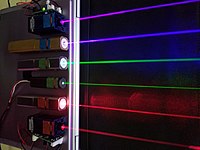
Photo from wikipedia
Abstract Black silicon fabricated by ultrafast laser is a promising material for infrared detection. However, the structure–property relationship in laser-fabricated amorphous Si is still unclear. By first-principles calculations, different distorted… Click to show full abstract
Abstract Black silicon fabricated by ultrafast laser is a promising material for infrared detection. However, the structure–property relationship in laser-fabricated amorphous Si is still unclear. By first-principles calculations, different distorted local structures are revealed depending on cooling rate. By comparing the evolutions of structure and property, the bond angle distribution is identified as a good structural descriptor for sub-band absorptions. Glass formation is not simply a freezing of liquid but involves certain structural transitions that happened between 1350 and 850 K. A glass-forming temperature of 1100 K is further revealed which agrees with experiments. The main thermal-management effect is the duration time of glass-forming process. A shorter-pulse laser leads to more distorted structures and thus more defect states and infrared absorptions.
Journal Title: Results in physics
Year Published: 2021
Link to full text (if available)
Share on Social Media: Sign Up to like & get
recommendations!